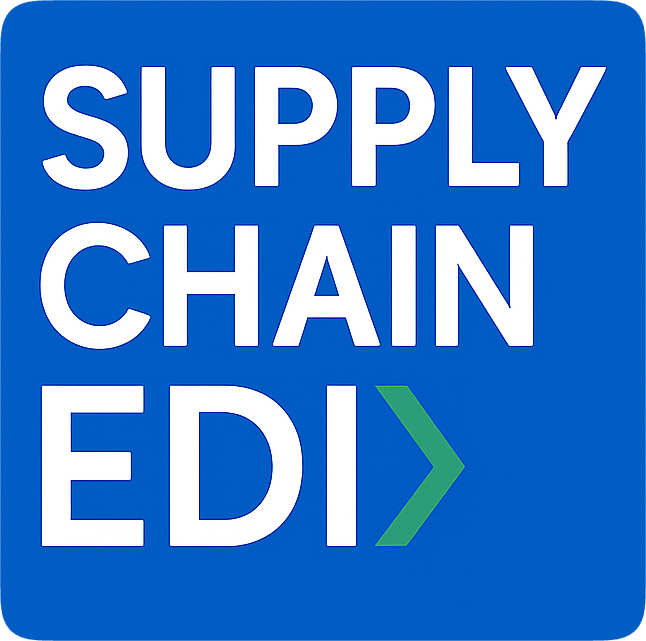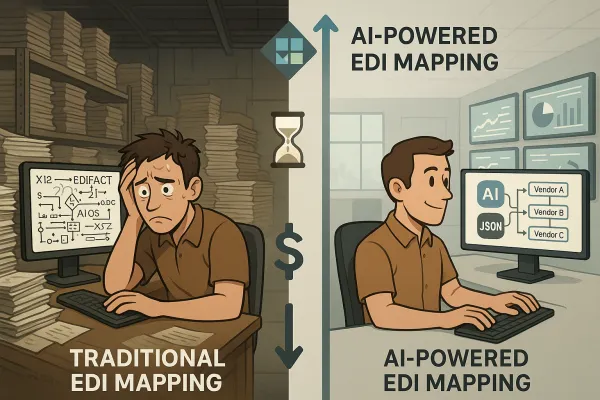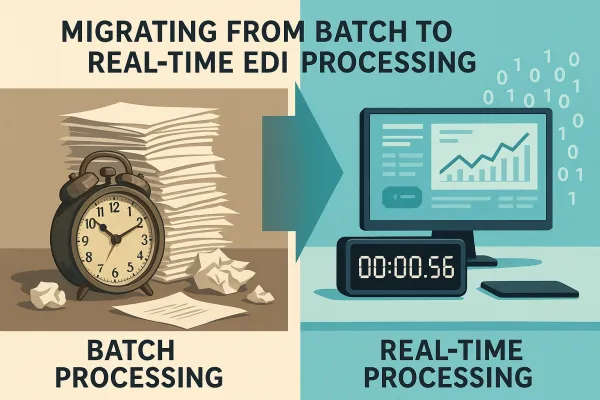EDI Managed Services vs In-House Implementation: The Complete ROI Analysis Framework for 2025 Decision-Making

EDI managers face a decision that will define their operations for years to come. With the global EDI software market valued at $2.08 billion in 2024 and projected to reach $5.30 billion by 2032, the stakes couldn't be higher. The EDI market is expected to reach $11.2 billion by 2025, driven by the urgent need for efficient data exchange in an increasingly digitized landscape.
This comprehensive ROI analysis framework will guide you through the managed services versus in-house implementation decision, providing the data-driven methodologies needed to justify your 2025 EDI investment strategy.
The Critical Decision: Why EDI Deployment Strategy Matters More Than Ever in 2025
The pressure on supply chain technology leaders has never been more intense. Companies with 100+ suppliers face complex integration demands that stretch internal resources thin. The biggest reasons companies seek managed service providers are often a lack of in-house expertise/knowledge and/or a lack of internal bandwidth.
The growth of the market is primarily driven by the rising preference of large organizations toward in-house processing and digital transformation & process automation, yet the reality on the ground tells a different story. EDI specialists are scarce, and the technical complexity continues to grow.
Manufacturing companies processing just-in-time orders can't afford downtime. Retailers managing seasonal peaks need scalable solutions. Healthcare providers processing insurance claims require bulletproof compliance. Each scenario demands a different approach to ROI calculation, but all require one thing: measurable financial returns that justify the investment.
Understanding Total Cost of Ownership: Beyond the Sticker Price
Most EDI cost analyses fail because they ignore hidden expenses that erode ROI over time. The cost of an EDI system can vary depending on various factors such as the size of your business, the complexity of your EDI requirements, the number of trading partners you need to connect with, and the specific EDI software or service provider you choose. A basic setup may cost a few hundred dollars per year, while a more advanced system with multiple trading partners can range into several thousand dollars annually.
Here's what the real numbers look like:
On-Premise Implementation Costs:
- Initial software licensing: $50,000-$250,000
- Hardware infrastructure: $25,000-$100,000
- Implementation services: $75,000-$300,000
- Staff training and onboarding: $15,000-$50,000
- Annual maintenance: 18-22% of license cost
Hidden Ongoing Costs:
- Subscription or hosting fees for cloud EDI platforms, regular updates to meet new compliance or trading partner requirements, IT staff time or vendor fees for system maintenance and troubleshooting
- Compliance charges if outbound documents aren't meeting trading partners' requirements. Often charged per document, these can add up quickly if the problem is systemic
- Integration complexity with transport management systems like Cargoson, MercuryGate, or Descartes
EDI software licences: Buying an on-premises licence is often more expensive than paying a rolling fee for a cloud-based or managed service. 70% of businesses now rely on cloud-based business apps, forecast to rise to 85% by 2025.
EDI Managed Services: The Outsourcing Value Proposition
EDI managed services encompass outsourcing the complete lifecycle management of your Electronic Data Interchange (EDI) infrastructure and operations to a third-party provider. This model removes the burden of technical complexity while providing predictable costs.
The financial benefits are immediate and measurable. For suppliers, Forrester identified a savings of $256K/three-year benefit present value (PV) by eliminating the need for internal resources dedicated to EDI. Another $460K (three-year NPV) of savings occurred by relying on managed services to deploy and test ongoing retailer changes to their EDI requirements.
Managed service EDI traditionally operates on a subscription-based model. That said, managed service EDI isn't guaranteed to be cost-effective, with poorly chosen providers posing price-based risks. The key lies in finding providers that offer:
- 24/7 monitoring and faster issue resolution
- Complete trading partner onboarding management
- Automatic compliance updates and testing
- Integration support for systems like Cleo Integration Cloud, TrueCommerce, or specialized TMS platforms
Forrester's cost-benefit analysis of EDI found that companies experience benefits of $1 million over three years, with a payback period of fewer than three months and an ROI of 372 percent.
In-House EDI Implementation: Control vs Complexity
The allure of complete control drives many organizations toward in-house solutions, but the reality proves more challenging than anticipated. While a company may opt for on-premise EDI, they often discover it is costly and complex to maintain. Depending on their trading partners' requirements, companies will have to be familiar and support data standards like TRADACOMS, EDIFACT, and XML and protocols like AS2 and SFTP.
The financial implications of in-house EDI deployment have been its downfall, with the need to employ dedicated teams of professionals causing costs to rise. Furthermore, to be effective, in-house EDI must respond to market changes, which creates additional costs.
In-house makes sense when you have:
- Existing EDI expertise and dedicated IT resources
- High transaction volumes justifying infrastructure investment
- Complex customization requirements unique to your industry
- Strict data sovereignty requirements
Transport management integration adds another layer of complexity. Whether connecting to Cargoson, nShift, or FreightPOP, internal teams must manage multiple APIs, data mapping, and ongoing maintenance across platforms.
The ROI Calculation Framework: Making Data-Driven Decisions
Return on Investment (ROI) for EDI refers to the measurable financial return a business gets from its investment in EDI software, systems, and services. It includes direct cost savings and indirect benefits such as improved efficiency, compliance, and scalability.
A study by GS1 US estimates that EDI transactions can save companies $1 to $3 per document. For a company processing 50,000 documents annually, this translates to $50,000-$150,000 in direct savings.
ROI Calculation Methodology:
Step 1: Calculate Total Benefits
- Direct cost savings: Manual Data Entry reduction, Paper/Printing/Postage elimination, Order Processing Time acceleration, Error Reduction, Invoice and Payment Processing speed improvement
- Error reduction benefits: Manual processes produce errors. Companies estimated a standard error rate of 5% for manual processes and an increase to a 33% error rate during peak seasons. You can calculate the cost of these errors across the supply chain, including chargebacks
- Cash flow improvements: Faster invoice processing and payment cycles
Step 2: Calculate Total Costs
- EDI Software Licensing and Subscription Fees, Hardware Infrastructure, Training and Onboarding, EDI Implementation and Integration
- Ongoing operational expenses and maintenance
Step 3: Apply ROI Formula
Basic ROI Formula: (Net Benefits – Costs) / Costs × 100
Example Calculation:
Manufacturing company with 75,000 annual transactions:
- Annual benefits: $225,000 (75,000 × $3 average savings)
- Managed service annual cost: $85,000
- ROI: ($225,000 - $85,000) / $85,000 × 100 = 165% ROI
Decision Matrix: Choosing the Right Path for Your Organization
Your EDI decision depends on multiple factors that interact in complex ways. Choosing between a full service provider or a managed EDI service provider depends on various factors, including budget, in-house expertise, scalability requirements, and the level of control desired. Full service providers offer more control and customization options but require more internal management, while managed service providers provide convenience and expertise with lower upfront costs.
Choose Managed Services When:
- You have 100-1,000 trading partners with standard requirements
- Limited internal EDI expertise or bandwidth
- Need rapid deployment (3-6 months vs 12-18 months for in-house)
- Seasonal transaction volumes requiring flexible scaling
- Integration with multiple TMS platforms like Cargoson, Manhattan Active, or Blue Yonder
Choose In-House When:
- 1,000+ trading partners with complex, unique requirements
- Existing EDI team and infrastructure
- Industry-specific customizations (automotive EDI, healthcare claims processing)
- Data sovereignty or security requirements that prevent cloud deployment
Consider Hybrid Approaches When:
- You want the control and flexibility of self-service with the convenience and expertise of managed services
- Transitioning from legacy systems over time
- Managing both standard and highly customized trading partner relationships
2025 Market Trends Impacting Your Decision
Several technology trends are reshaping EDI ROI calculations for 2025. The integration of EDI solutions with blockchain technology is emerging as a key trend, enhancing security and efficiency. Companies in the market for electronic data interchange (EDI) solutions are developing software incorporating artificial intelligence (AI) and the Internet of Things (IoT).
AI and machine learning integration promise to automate complex data mapping and reduce errors. Cloud-native architectures are becoming standard, offering better scalability and reduced infrastructure costs. As companies are looking for adaptable, scalable, and affordable methods to oversee their data interchange, the need for cloud-based EDI solutions is increasing.
API-first EDI systems are emerging, combining EDI reliability with modern API flexibility. This hybrid approach allows companies to maintain EDI compatibility while embracing newer integration methods for modern trading partners.
Action Plan: Your 5-Step Implementation Decision Process
Step 1: Assess Current State
Document your current transaction volumes, trading partner requirements, and internal capabilities. Include existing TMS integrations and future connectivity needs.
Step 2: Calculate Baseline ROI
Use the framework above to establish your financial baseline. Accurate data is the foundation of reliable ROI analysis. Companies must ensure that their data flows are clean, complete, and standardized. Implementing robust validation protocols and automated reconciliation processes can help maintain data integrity.
Step 3: Evaluate Vendor Options
Compare managed service providers like Cleo, TrueCommerce, and SPS Commerce. For in-house solutions, assess platforms that integrate well with your TMS, whether that's Cargoson, Transporeon, or Oracle Transportation Management.
Step 4: Build Implementation Timeline
EDI integration reduces trading partner onboarding time by up to 50% with prebuilt templates. Factor this acceleration into your ROI timeline.
Step 5: Monitor and Optimize
EDI is not a one-time investment. Ongoing costs should be factored into ROI measurements to get a realistic view of profitability. Establish quarterly reviews to track actual ROI against projections and adjust strategies accordingly.
The choice between managed services and in-house EDI implementation will shape your supply chain efficiency for years to come. Use this framework to build a compelling business case that secures stakeholder buy-in and delivers measurable results. Whether you choose the control of in-house solutions or the expertise of managed services, the key is aligning your decision with measurable business outcomes that drive competitive advantage.





